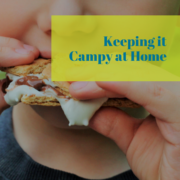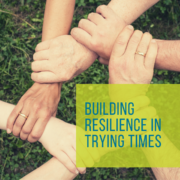Keeping it Campy at Home
A recent realization is coming down hard on many families right now as we move into the summer months—cancelled summer camps and other beloved outdoor activities. Due to the Covid-19 pandemic, many organizations have been forced to postpone or cancel their summer programs and events. Besides deposits, schedule changes, and other logistical obstacles, families are now left to improvise for children who have been left disappointed by these cancelled programs. Despite the fact that camps, at least in the traditional sense, won’t be happening this summer, families do not have to forego all of the activities and traditions. Below are ideas for bringing camp activities and traditions back with an at-home spin!
Ask for ideas
Before setting out to plan for summer camp at home, ask your kids about their favorite parts of camp. Which activities do they prefer? How do they typically spend the day? How much adult involvement do they expect? What props, supplies, or materials will they need for their activities? By asking these questions, parents can plan for activities that will truly engage children in a meaningful way. Answers to these questions will also help parents to get an idea of the vibe or type of camp that is most relevant. For instance, a soccer camp is going to be much different from a wilderness-style camp.
Provide a schedule
Creating structure will make the at-home camp experience feel more authentic. Since all camps, from sleepaway camps to sports-focused day camps, provide a level of structure and consistency, an outline of activities for the day or week will elevate the in-home camp experience. Parents can sketch out the week’s activities or a daily schedule on a white board or take it to the next step by printing a camp “brochure” for each camper. Below is a sample idea for a daily camp schedule–with typical camp protocols included:
| Time | Activity | Dress |
| 8:00-8:30
*Change into active wear after bfast & apply sunscreen |
Breakfast in mess hall (kitchen) *Bunk must be made prior to meal | Pajamas |
| 9:00-10:30 | Neighborhood scavenger hunt | Sneakers; athletic clothes |
| 10:30-11:30 | Indoor/Outdoor game time
*Choice of frisbee, cornhole, boardgame, hopscotch/jump rope challenge |
Sneakers; athletic clothes |
| 11:30-12:30 | Lunch in mess hall (kitchen)
*Must wash hands prior to meal; clean up dishes after meal |
|
| 12:30-2:30
*Reapply sunscreen after quiet time |
Quiet time activities
*Choice of craft, baking, screen time, reading, coloring, puzzle, movie |
Comfy clothes |
| 2:30-3:30 | Water time
*Choice of water balloon toss, sprinkler time, slip n’ slide, pool or water table, squirt gun fight |
Swimsuit; towel |
| 3:30-4:00 | Snack time | Dry clothes |
| 4:00-5:30 | Backyard obstacle course | Sneakers; athletic clothes |
| 6:00-7:00 | Family dinner in mess hall (kitchen) *Must wash hands prior to meal; rotating schedule of campers setting the table | Apron for kitchen helper |
| 7:00-7:30
*Apply bug spray |
Stack firewood/gather kindling for campfire | |
| 7:30-9:00 | Campfire s’mores; spooky stories; star gazing | Sweatshirts (possibly) |
Of course, activities and times will vary depending on camper preferences and family schedules, but this sample provides a simple outline for parents to structure their at-home camp. This will require a bit of preparation and planning, but once the plan is in place and materials are gathered, older children (7+ years) could ideally run the activities themselves.
Another option is to share the schedule with other families in the neighborhood so that each house can get in on the fun. This also allows parents to divvy up the work, kind of like a progressive dinner, but with camp activities. An important consideration if hosting for the neighborhood—TRIPLE CHECK with parents about any allergies, food restrictions, medications needed (epi-pen), or health concerns that might impact a camper’s participation in outdoor/physical activities.













